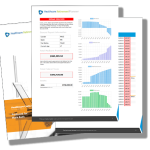2025 IRMAA Brackets: Medicare Costs
With more and more people receiving IRMAA Letters from Social Security the question that is starting to arise is where will the 2025 IRMAA Brackets be?
With any luck and an absence of Congress they will hopefully be much higher than where they are today.
What is IRMAA?
IRMAA is short for Medicare’s Income Related Monthly Adjustment Amount. It is a surcharge on top a Medicare beneficiaries Part B and Part D medicare prescription, if they are earning too much taxable income.
Simply put, IRMAA is a tax on income through Medicare.
What are IRMAA Brackets?
According to Social Security.gov IRMAA brackets are “a set of statutory percentage-based tables used to adjust Medicare Part B and Part D prescription drug coverage premiums.
“the higher the beneficiary’s range of modified adjusted gross income (MAGI), the higher the IRMAA. There are three sets of tables”.
These brackets “use the beneficiary’s tax status when using the table”. The tax status is broken into:
- Single, head–of–household, or qualifying widow(er) with dependent child tax filing status.
- Married filing jointly.
- Married filing separately.
The 2023 IRMAA Brackets are:
|
2023 IRMAA Brackets |
||
| Individual’s MAGI | Part B Premium | Part D Premium |
| < $97, 000 | $164.90 | Premium (varies) |
| $97, 000 to $123, 000 | $230.80 | $12.20 |
| $123, 000 to $153, 000 | $329.70 | $31.50 |
| $153, 000 to $183, 000 | $428.60 | $50.70 |
| $183, 000 to $500, 000 | $527.50 | $70.00 |
| > $500, 000 | $560.50 | $76.40 |
| Couple’s MAGI | Part B Premium | Part D Premium |
| < $194, 000 | $164.90 | Premium (varies) |
| $194, 000 to $246, 000 | $230.80 | $12.20 |
| $246, 000 to $306, 000 | $329.70 | $31.50 |
| $306, 000 to $366, 000 | $428.60 | $50.70 |
| $366, 000 to $750, 000 | $527.50 | $70.00 |
| > $750, 000 | $560.50 | $76.40 |
| Married filing separately | Part B Premium | Part D Premium |
| < $194, 000 | $164.90 | Premium (varies) |
| $97, 000 to $403, 000 | $527.50 | $70.00 |
| > $403, 000 | $560.50 | $76.40 |
BOOK YOUR FREE DEMO
FINANCIAL PROFESSIONALS
TAKE THE CONFUSION OUT OF IRMAA
If you are here you already know about IRMAA..but do you know how much it will reduce your clients Retirement income?

BOOK YOUR FREE DEMO
GET YOUR FREE MEDICARE IRMAA AND SOCIAL SECURITY STRESS TEST

GET YOUR FREE REPORT NOW
Do IRMAA Brackets change?
Yes, the IRMAA Brackets should change annually if there is inflation.
According to legislation Congress passed in the 2003 Medicare Modernization Act (MMA) the IRMAA Brackets must adjust annually based on inflation.
The reason why the IRMAA Brackets should change is that in 2010 with the passing of the Affordable Care Act the IRMAA Brackets were legislated to NOT change until 2028.
Starting in 2010 the IRMAA Brackets did not adjust at all regardless of what inflation was doing. By 2018 with the passing of the Bi-Partisan Budget Act (BBP 2018) not only did the IRMAA Brackets start to adjust again but the 5th IRMAA Threshold was created.
Since the passing of the BBPA in 2018 the IRMAA Thresholds have adjusted each year based on inflation.